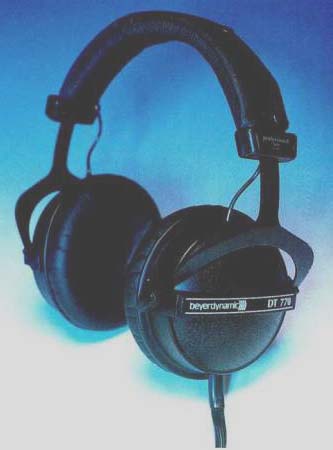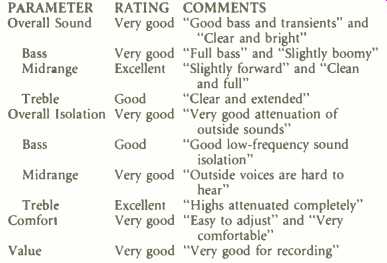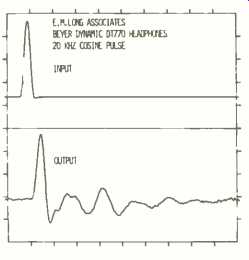
The DT 770 Pros are designed to be used as monitoring earphones by recording
engineers. They are similar, in some respects, to the DT
990 Pro earphones that I reported on in the April 1992 issue, but while the DT 990s were an open
design, Beyerdynamic has designed the DT 770s to reject outside sounds.
This makes then much more suitable for a wide range of recording applications, and anyone who has made field recordings with open type earphones will appreciate this.
The DT 770 earphones use a bass-reflex design; the reflex ports and the transducer diaphragm are on the face of the earcups and are coupled directly to the ear. Beyerdynamic has also designed the DT 770s to have a diffuse-field response, although, as I have said in previous reports, there is still no consensus among manufacturers as to the exact equalization necessary to accomplish this.
============
SPECS
Transducer Design: Dynamic.
Coupling to the Ear: Circumaural, closed.
Equalization: Diffuse-field.
Sensitivity: 96 dB for 1 mW.
Maximum Output: 116 dB for 100 mW. Impedance: 600 ohms.
Price: $249.95.
Company Address: 56 Central Ave., Farmingdale, N.Y. 11735.
MEASURED DATA
D.C. Resistance: Left, 568 ohms; right, 571 ohms.
Absolute Polarity: Positive.
Cord: Coiled, 10 3/4 feet long, with 1/4-inch stereo phone plug.
Adjustments: Headband slides in hail, with detents.
Weight: 9 ounces.
==============
The DT 770 Pro headband consists of two spring-steel bands covered by a removable, foam-filled leatherette cushion. The spring tension was perfect for me, and the bass increased only slightly when I pressed the earcups more tightly to my head. The headband springs are terminated at each end by a plastic retainer that is held in place by two screws. A label is recessed into each of them--"Right" and "Left" in light lettering on a black background that is easy to see, even in the dim lighting found in some control rooms and field recording situations. There appears to be a serial number stamped into the rear of the left retainer; this is another indication that the DT 770 is definitely a professional product. The bails holding the earcups are also metal rather than the plastic used on most earphones; they have embossed detent pits that mate with position-holding springs inside the retainers. The top of the bails swivel slightly to allow a really good fit to the head.
The cushion covering the headband springs has four snaps that allow easy removal for cleaning and replacement. The foam-filled ear cushions, of the sane leatherette material as the headband cushion, are also removable for cleaning. A soft circular flap on the rear of each ear-cushion fits around the hard rim of the plastic earcup; if you have ever replaced a bicycle tire, you will know how to replace these earcushions. The transducer elements are mounted in the face of the earcup plate.
This plate, which also has the openings for the bass-reflex ports, is covered by acoustically transparent foam, which touches the outer ear when you put on the earphones.
The DT 770s are very comfortable, which you will appreciate very much if you do any extended recording or listening. The coiled cord exits from the bottom of the left earcup through a flexible strain relief; it extends to about 10 3/4 feet and is extremely flexible.
The seal between the DT 770s and the head is, as with most earphones, most effective at reducing the penetration of outside sounds at higher frequencies but is still very good down to the bass range. A leak between the earphones and the head can cause a reduction in the bass output, but Beyerdynamic engineers appear to have compensated the DT 770s for a slight amount of leakage. When I wore them in the normal position, with the earcushions against my head, the sound of pink noise was very smooth and without noticeable coloration; when I pulled them away from my head, the sound varied from an "oooh," close to my head, to an "awww," further away. The bass output also was reduced when I did this, as would be expected.
I compared the sound of the DT 770 earphones to that of the Stax SR-Lambda Pro Earspeakers, which serve as my present reference. The bass of the DT 770s was definitely stronger, and the comments of all the members of my listening panel--such as "stronger bass than reference," "full bass," and "bass slightly boomy"--agree with my perception. Perhaps Beyerdynamic designed the DT 770's bass response to compensate for the sort of leakage that is caused by long hair. I asked the members of my listening panel to rate the sound of the Beyerdynamic DT 770, compared to that of the Stax, and also to write down their comments while listening to a variety of program material.
My lab measurements showed that the response extended down to 20 Hz, with a bump at about 40 Hz. This correlates well with the panel's subjective comments about the quality in the bass range. Comments about the midrange (such as "clean and full," "very articulate on voices," and "slightly forward") also correlate very well with my measurements.
The listening panel all commented that the DT 770 sounded slightly brighter than the reference. There was a broad dip in frequency response at about 5 kHz; this may have caused one panel member to comment that the treble sounded "rolled off" and was "less than the reference" Since the measured high-frequency response of the DT 770s was about the same as for the Stax, I think this comment must be related to the fact that this panel member heard the midrange as being "clean and full" rather than "bright," as did other panel members. Another panel member, who had commented that the midrange was "slightly forward," said that the treble was "clear and extended." Sorting out comments and correlating them with my measurements isn't as easy as it might seem!
============
PARAMETER - RATING - COMMENTS

GENERAL COMMENTS: Smooth-sounding; a little heavy in bass range; very good transients and articulation; overall, very good value, especially for recording.
============

Fig. 1--Cosine-pulse test.
Figure 1 shows the output of the Beyerdynamic DT 770 earphones for a 20-kHz cosine-pulse input. The shape of the output pulse is very close to that of the input; the undulations, after the input stops, indicate that the damping is less than ideal but is nevertheless very good. The shape of the initial part of the output pulse correlates with panel comments such as "very good articulation" and "excellent on cymbals, blocks, etc." The pulse also shows that the earphones produce a positive acoustical output for a positive electrical input.
The impedance of the DT 770 Pros is a high 600 ohms, so they have no measurable effect on the response or output level of such different sources as receivers, preamps, and CD players. Despite their high impedance, these 'phones can produce a reasonably high sound pressure level from relatively little input power.
The Beyerdynamic DT 770 earphones are comfortable and can be worn for long periods; only the lack of outside noise makes you aware that you have them on.
The listening panel rated the sound quality and the comfort as "very good." The DT 770s are surprisingly close to the Stax SR Lambda Pro reference earphones, with more bass output and slightly less smooth response between 5 and 10 kHz. If you are looking for an excellent pair of earphones for recording or for listening without hearing outside noises, there is nothing available now that is better than the Beyerdynamic DT 770s.
---Edward M. Long
(adapted from Audio magazine, Mar. 1993)
Also see:
Beyerdynamic DT990 PRO Earphones (AURICLE, Apr. 1992)
Beyerdynamic DT-911 headphones--review, teardown and analysis (Jan. 1993)
Sennheiser HD-540 Reference II headphones (Jun. 1992)
= = = =